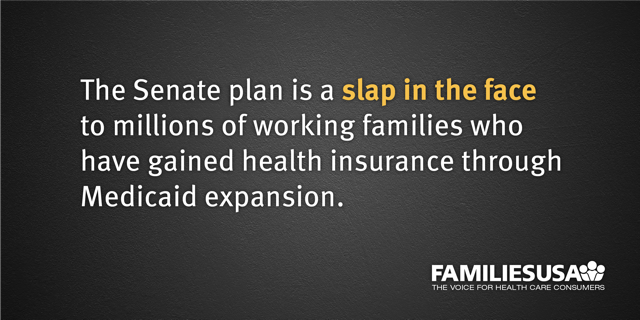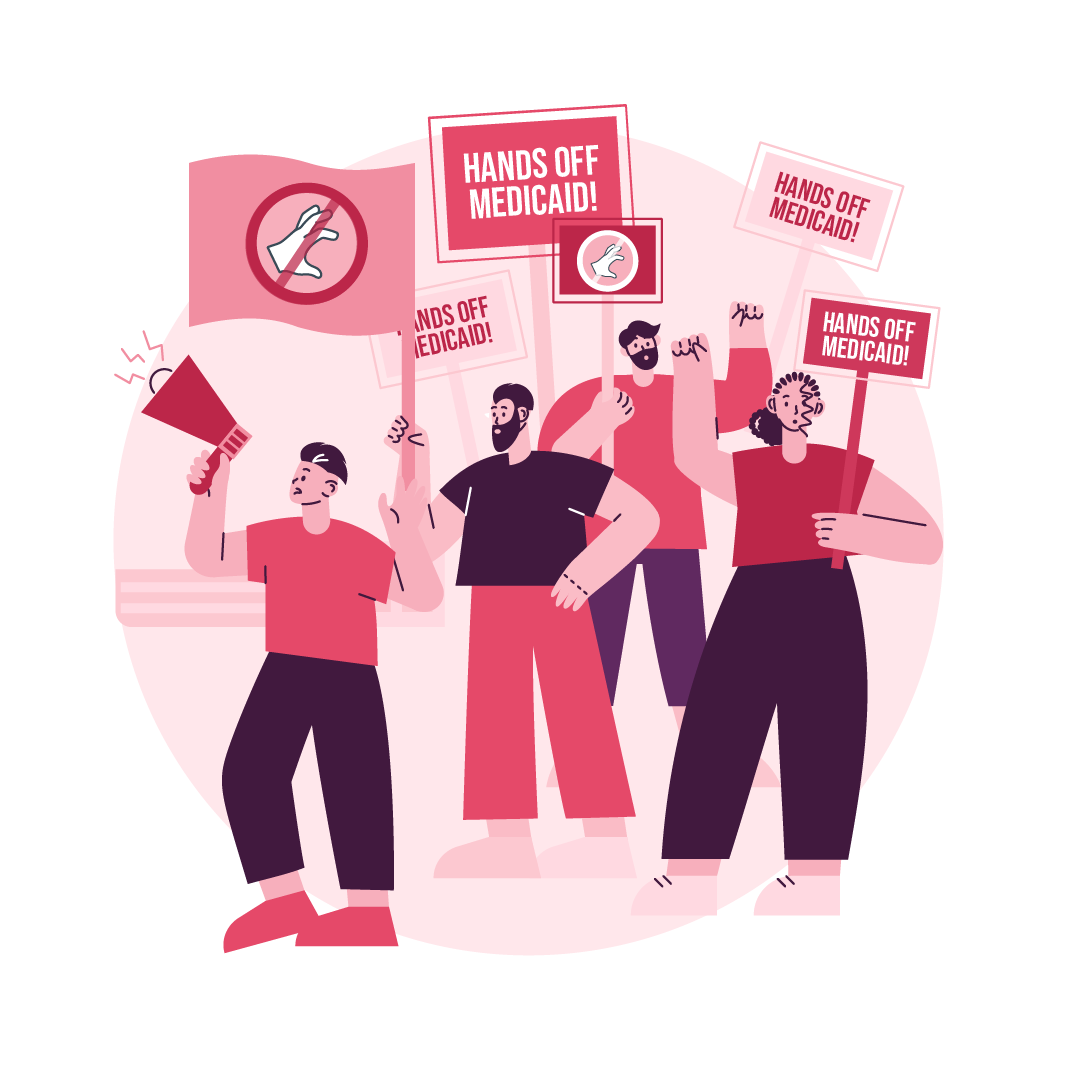
Senate Health Care Bill Inflicts More Harm than House Version
06.23.2017
The Senate Republicans finally released their bill to repeal the Affordable Care Act. It is now evident why Senate leadership has attempted to withhold details of this bill from the public. This bill would only inflict more harm on people’s access to health care, compared to the House repeal bill that the nonpartisan Congressional Budget Office (CBO) estimated would strip coverage from 23 million people.
The Senate bill would do the following:
- End the Medicaid expansion, ensuring that millions of low-income workers will lose health coverage
- Radically cut Medicaid for all states by capping and cutting federal spending and passing significant costs on to states, essentially ensuring that they will cut their programs
- Allow states to eliminate the essential health benefits and minimum coverage requirements that are core protections for people with pre-existing conditions
- Cut financial assistance for private coverage and eliminate all assistance with out-of-pocket costs like deductibles
- Institute an age tax on premiums, allowing insurers to charge older people five times the premium of younger people
- Provide billions of dollars in tax cuts to the millionaires and corporations
The Senate bill ends the Medicaid expansion, ensuring that millions of low-income workers will lose health coverage
Like the House bill, the Senate bill ends the Medicaid expansion. It cuts federal funding for the expansion across the board starting in 2021, ending the expansion’s added match within three years. States will have to pick up the lost federal funding, and few if any will be able to do so. Expect states to pull out of the Medicaid expansion even before expansion funding ends on January 2024, leaving 11 million residents across 31 states without health care.
To try to sell this, the bill allows people with incomes below poverty to buy coverage on the marketplace. But that’s just window dressing, not a real option.
For someone living at the poverty level ($12,060), marketplace coverage would mean premiums at 2% of income plus massive exposure to out-of-pocket costs that could total half their yearly income, or more. Medicaid, in contrast, limits how much people have to spend on out-of-pocket costs so that they can actually afford to get the care they need. Not so with the Senate plan. It’s a slap in the face to millions of working families who have gained health insurance through the expansion.
The Senate Bill radically cuts Medicaid for all states by capping and cutting federal spending and passing significant costs on to states, essentially ensuring that they will cut their programs
Like the House bill, the Senate bill would replace the current guarantee of the federal government matching state Medicaid spending with capped and severely cut federal funding. However, in the Senate bill, the cuts are even deeper.
Starting in 2020, federal Medicaid payments would be capped with a growth rate set at the Consumer Price Index for medical care (CPI-M) for most enrollees; for seniors and people with disabilities, the growth rate would be CPI-M plus 1 percent. CPI-M measures inflations in what consumers pay out-of-pocket for medical care.
But state Medicaid programs are directly paying for health care. They are on the hook for total price increases across nursing homes, hospitals, doctors and other health care providers. That’s not the same as increases in what consumers—including those with good insurance—pay out of pocket. It can be a lot more.
Things get worse for states in 2025, when the inflations adjustment drops to the standard consumer price index for all Medicaid enrollees. That is huge cut for states. CPI measures average inflation, which is a lot less than even the inadequate measure of CPI-M. General CPI has been less than CPI-M for nearly every year since inflation tracking began. For example, in 2016, CPI-M went up 4% and general CPI went up 1.7 percent.
The Senate bill would cut billions in Medicaid for all states—those that did and didn’t expand Medicaid. States, which have to balance their budgets, will be forced to choose between cutting care for children, long-term care for seniors and people with disabilities, or care for working families and raising taxes and or cutting other services. It’s a choice that will hit residents in every state.

The Senate bill penalizes states that do more for their residents
The Senate bill would go beyond generally cutting Medicaid funding for every state and penalize states that are more generous with who and what they cover in Medicaid.
The bill would penalize states that spend 25 percent more than the national per enrollee average for any given category of enrollees by cutting federal funding up to 2 percent—that can add up to millions for a state with a lot Medicaid enrollees. While this is billed as “promoting equity across the states,” what it really does is penalize states that have chosen to cover more services, or have higher costs of living, and therefore higher health care costs or perhaps are confronting a health care crisis that is raising health care costs, like the current opioid epidemic.
This is the opposite of state flexibility. It is a federal push for states to do less. And coincidentally, most of the states that would be penalized tend to lean Democratic.
The Senate bill guts financial assistance with coverage, leaving millions to pay more for less coverage
Just like the House bill, the Senate bill would cut financial assistance to help lower- and middle-income people purchase comprehensive coverage on the individual market. The bill makes substantial changes to the ACA’s tax credit structure ensuring that individuals who qualify for financial assistance will receive less help to purchase coverage and the coverage they are able purchase will be far less comprehensive.
The bill ties tax credits to plans that cover only 58 percent of health care costs, compared to 70 percent under current law, meaning anyone eligible for financial assistance will be forced to purchase less generous coverage with significantly higher out of pocket costs or pay substantially more for the comprehensive coverage they have today. In practice, this change means that most enrollees would see their deductibles increase about $4,000, to $7,350 a year.
While still pegged to income, tax credits diminish significantly for households that include someone over age 50, and phase out for everyone with incomes over 350 percent of the federal poverty level. Individuals are no longer eligible for tax credits if they have an offer of insurance from their employer, no matter how bad.
The bill eliminates all tax credits for people with incomes between 350 percent and 400 percent of poverty. This is a large, middle class population that will struggle to afford health insurance without assistance. For example: A 60 year old making $47,000 a year (400% FPL) would see their premiums skyrocket to over $11,300 a year, about $6,700 more than what they would pay with financial assistance for the same coverage under current law.
The bill would also eliminate all financial assistance to help lower out-of-pocket costs, stripping vital help affording care from almost 6 million people. As a result, these people would see their deductibles, copays and other out-of-pocket costs increase by hundreds to thousands of dollars.
In total, millions of working families would have to pay much higher premiums, for worse coverage with much higher out-of-pocket costs.
The Senate bill allows insurers to charge older people even higher premiums
Just like the House bill, the Senate bill would allow insurers to charge older people five times the premiums of younger people. This would undo a key protection in place today that caps older people’s premiums at three times the premiums of younger people.
On top of this, the bill would drastically cut financial assistance with premiums for older people by requiring older, middle-income adults pay a greater percentage of their income in premiums. With this change alone, a 60 year old making just over $42,000 a year (350% FPL) would see their premiums increase by nearly $2,750 a year for coverage with substantially higher deductibles.
As a result of this increase in premiums and cuts to assistance, older adults would see their premiums sky rocket under this bill.
The Senate bill will decimate nationwide protections for the 1 in 2 people with pre-existing conditions by allowing states to eliminate essential health benefit standards that ensure plans cover the care people need
Just like the House bill, the Senate bill will give states broad latitude to gut protections for people with pre-existing conditions by waiving essential health benefits standards. The bill allows states to apply for the ACA’s 1332 waivers with near automatic approval by the federal government and little public input. It also strips the guardrail requirements related to comprehensive coverage and affordability. In essence, this will make it possible for states to easily eliminate essential health benefits requirements, effectively allowing plans to exclude coverage of services needed by people with pre-existing conditions.
This will be a return to a time before the ACA when plans routinely didn’t cover the services people needed like mental health care, substance use treatment, and maternity care. Under the Senate bill, plans could decide not to cover benefits often needed it people with serious illnesses, like specialty drugs, rehabilitative and habilitative services. Women could lose maternity care coverage or be forced to pay more than a thousand dollars in higher premiums for this coverage, taking us back in time to the days when being a woman was a pre-existing condition in the individual market.
Under the senate bill, an insurer would be still be required to offer coverage to an individual with cancer, but would not be required to sell plans that cover core categories of benefits people with cancer might need, like prescription drugs. In states that waive these requirements, coverage options would erode leaving people with pre-existing conditions with no affordable, comprehensive coverage options and rendering them effectively uninsured.
Moreover, many of the changes to the individual market discussed above, coupled with the repeal of the individual mandate, will put significant pressure on states to seek waivers – making it less of an option and more of an inevitable outcome. Because coverage will become increasingly costly, and there will no longer be a requirement for everyone to purchase insurance, only those that need to will buy insurance. This dynamic will create extreme adverse selection problems for states that would likely force them to take up a waiver. In the end, the outcome is the same: people with pre-existing conditions will lose vital protections under this bill, putting their health and financial security at risk.
Changes made on June 26 to the bill include a provision that would lock people out of coverage if they had to go without coverage the prior year. Included in the BCRA are waiting periods of 6- to 12-months for those who go without coverage for more than 2 months in the previous year. This “continuous coverage” provision only serves as a more harmful, less effective individual mandate. Rather than maintaining the individual mandate’s one-time fee for forgoing coverage, this latest proposal would mean that those who want to enroll in coverage after having a gap in coverage will be out of luck and left to the ranks of the uninsured for up to a year. This does little to address concerns about a balanced risk pool and will have an impact on everyone—with consequences being felt disproportionately by those with pre-existing conditions who are most in need of care.
The Senate bill is a tax cut for the wealthy
Like the House bill, the Senate bill would immediately end nearly a trillion dollars in taxes. This massive tax cut—arguably as much a driving forces behind the rush to pass a health bill as anything else—would disproportionately benefit the wealthy and large corporation. And how does the bill pay for these massive tax cuts? By cutting health care for the poor and middle class, that’s how.




